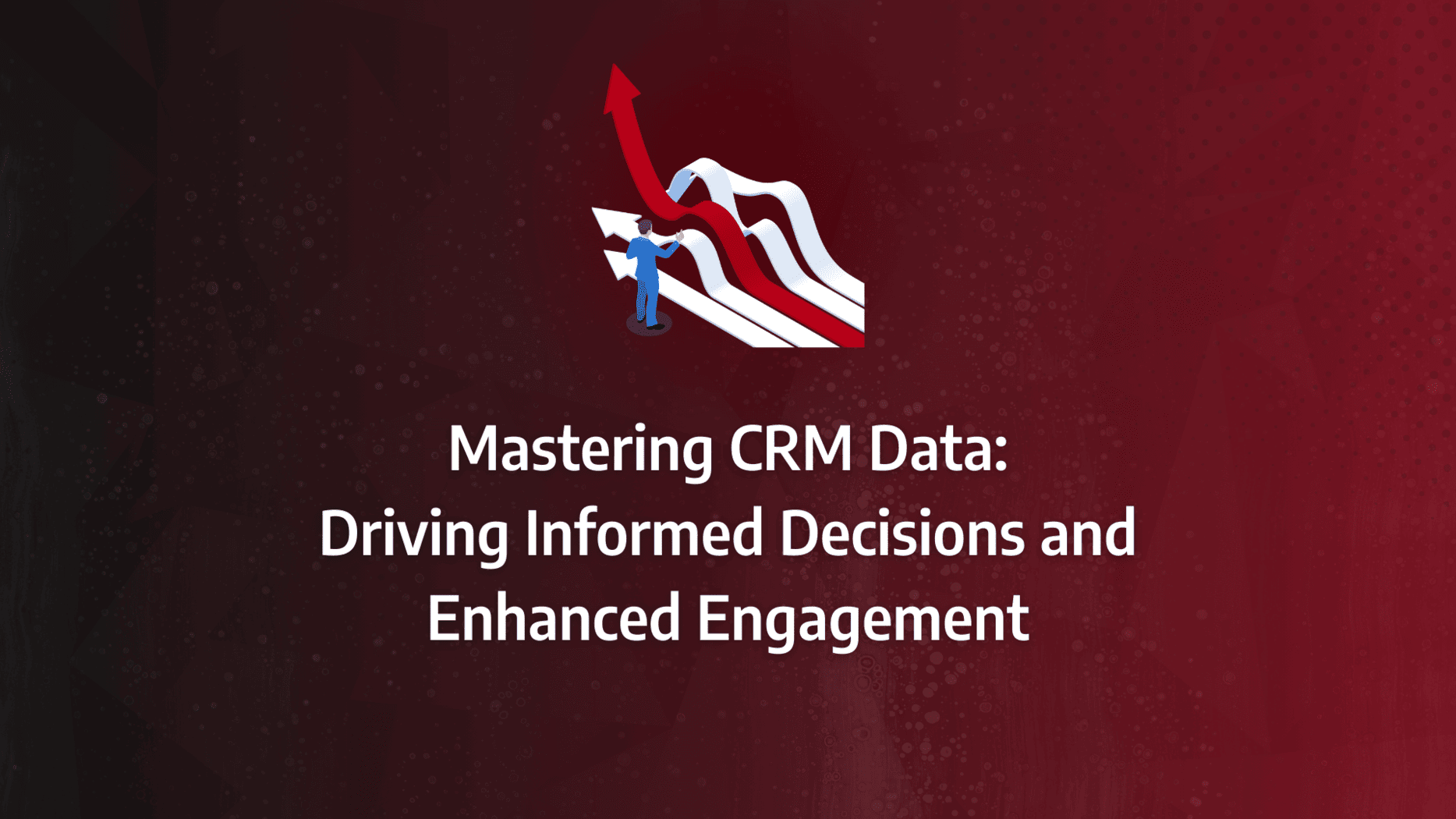Is your CRM data helping or hurting your business? Imagine investing significant resources into a CRM system, only to find that poor data quality is undermining your entire operation. Duplicate records, missing contact details, and outdated information aren’t just annoyances—they’re costly liabilities that can derail your marketing, sales, and customer engagement efforts.
But what if there was a way to turn this around? By addressing these data integrity issues head-on, you can transform your CRM from a source of frustration into a powerful tool that drives informed decisions, enhances customer relationships, and ultimately boosts your bottom line.
- Identify and Rectify CRM Data Issues: Regularly audit your CRM data for errors, duplicates, and outdated information to maintain accuracy and reliability.
- Implement Robust Data Management Practices: Establish data cleansing, validation checks, and regular updates as part of your CRM strategy to ensure data integrity.
- Leverage Automation for Data Accuracy: Use automated tools to reduce manual data entry errors and ensure real-time updates, improving overall data quality.
- Align CRM Data with Business Objectives: Ensure that your CRM data strategy supports your broader business goals, facilitating better decision-making and enhanced customer engagement.
- Invest in Training: Educate your team on the importance of CRM data integrity and how to maintain it, ensuring everyone contributes to a high-functioning CRM system.
The Impact of Bad CRM Data
Data serves as the backbone of business strategy and forecasting, yet many decision-makers fail to grasp the full extent to which poor CRM data integrity can cripple marketing, sales, and ultimately, the bottom line.
Poor CRM data—whether incomplete, inaccurate, incorrectly categorised, non-conforming, or duplicated—gradually erodes the system’s effectiveness. This results in spiralling costs to rectify what often begins as minor data errors. Over time, these errors accumulate, leading to a profound impact on a company’s CRM data strategy and overall efficiency.
1. It Severely Limits ROI
Consider this scenario: for a team of 50 users over three years, factoring in administrators and additional integrations, the total spend on a CRM system can reach approximately $400,000. That investment becomes entirely wasted if users don’t trust the output due to poor CRM data quality.
When sales representatives are forced to sift through duplicate records or hunt for accurate contact details, their efficiency plummets. Moreover, if crucial data is missing or incorrect, they may turn to other methods, further undermining CRM adoption. These inefficiencies snowball, limiting the return on investment and making it difficult for teams to capitalise on the CRM’s full potential.
2. Inconsistent Data Breeds Distrust
Consistency is key to establishing trust in CRM data. When data quality fluctuates, it erodes confidence in the system, making it harder for teams to rely on the information for critical business decisions. However, if CRM data integrity is maintained, users are more likely to trust the system, leading to increased usage and a stronger reliance on the CRM for forecasting and decision-making.
Take marketing, for instance. If a marketing professional encounters errors in segmentation—caused by inaccurate or missing data—they are likely to see a spike in email bounce rates, further reducing their trust in the system. The knock-on effect is less effective marketing campaigns and wasted resources, all of which are a direct result of poor CRM data quality.
3. It Encourages Poor Data Habits
Inconsistent or poor-quality data doesn’t just impact outcomes—it also fosters a culture of complacency. Users who have experienced bad data are less likely to prioritise inputting accurate information. They may assume that the data quality is already compromised, leading to a vicious cycle of deteriorating data standards. When users trust the system and see the value of maintaining accurate records, they are much less likely to “muddy the waters” with poor data input.
For managers who rely on CRM data for accurate pipeline forecasting, poor data quality can be catastrophic. When duplicates, missing fields, or inaccuracies plague reports, managers may look elsewhere for the information they need, further eroding trust in the CRM system and sending the wrong message to teams.
What Matters Most?
Capturing the entire customer journey in your CRM data is vital; this enables comprehensive analysis that informs both strategic decision-making and effective marketing efforts. Clients often discover that fostering a data-driven culture across their organisations significantly enhances alignment and effectiveness, as all teams utilise CRM insights in their strategies. Additionally, leveraging CRM data to create detailed customer personas that reflect current behaviours and preferences allows for more targeted marketing approaches, driving better engagement and outcomes.Get In Touch
Benefits of a Good CRM Database
A CRM system’s true value lies in its ability to deliver precise, trustworthy information to the right customer at exactly the right time. An effective CRM database is a critical foundation for a company’s CRM data strategy, helping to streamline processes and boost efficiency. Let’s explore three key benefits of maintaining a high-quality CRM database:
1. Personalised Customer Experience
Successful marketing hinges on understanding precisely who to target, and when. Whether it’s for a specific product launch, a promotional offer, or a personalised reward, accurate customer insights are essential. These insights come from a well-governed CRM database that integrates all available data into a single source of truth. When CRM data integrity is upheld, marketing teams can craft the personalised experiences that today’s customers expect, driving better engagement and brand loyalty.
2. Accelerated Sales Processes
A high-functioning CRM database significantly speeds up the sales cycle. By consistently organising and maintaining up-to-date customer information in real time, a CRM data strategy becomes more actionable. Salespeople and marketers can access crucial client data quickly and efficiently, regardless of where they are. The ability to handle multiple data streams, and integrate them seamlessly into one system, ensures that teams are always equipped with the most relevant data when they need it. This reduces the friction often caused by incomplete or outdated data, allowing for faster, more informed decision-making.
3. Compliant Governance for Privacy and Access
In today’s data-driven landscape, both customers and regulators demand stringent data privacy measures and easy access to personal information. A well-maintained CRM database not only facilitates efficient data management but also ensures compliance with evolving data protection regulations. When CRM data quality is high, companies can avoid costly data breaches, and in the event of an issue, they can swiftly rebuild trust with their customers by demonstrating a robust response. Proper governance around data access and security is critical to maintaining both compliance and customer confidence.
What types of data can be stored in a CRM system?
For any CRM system to function optimally, it must house several types of data. These are the essential categories:
1. Identity Data
Identity data encompasses basic information that helps identify your customers and leads. This data is fundamental for targeting efforts and can include:
- Full name (first and last)
- Mailing address
- Email address and telephone number, with a note of their preferred contact method
- Social media links and handles
- Personal details such as date of birth or account-specific information
2. Descriptive Data
Descriptive data provides deeper insights into the lifestyle and preferences of your contacts, helping to shape a holistic view of their personal and professional choices. Examples include:
- Career and education details (e.g., company name, profession, education level)
- Family details (e.g., marital status, number of children)
- Lifestyle information (e.g., homeownership status, car ownership, general interests)
Source: Resco
3. Quantitative Data
Quantitative data is invaluable for understanding how customers and leads interact with your business. It includes measurable points such as:
- Number of purchases made and average order value
- Frequency of website visits and traffic sources
- Service tickets raised
- Engagement on social media platforms
4. Qualitative Data
Qualitative data delves into customer attitudes, motivations, and behaviours, offering insights that can inform marketing strategies and decision-making. This data is typically gathered through surveys and direct feedback and may include:
- Customer satisfaction ratings
- Feedback on purchases
- Reasons for purchase (e.g., personal use, gift)
- Motivations behind choosing a specific product
Data Migration: 4 Steps to Getting Started with a CRM Database
Customer data is scattered across numerous channels—emails, spreadsheets, Post-it notes, social media platforms like Facebook, LinkedIn, and Twitter. For a CRM system to function effectively, it must centralise all this data, enabling meaningful client interactions and insightful analyses. Achieving this, and maintaining it in real time, requires a structured and secure CRM data migration strategy.
At first glance, migrating data into a CRM system might seem overwhelming, but by breaking it down into clear, actionable steps, the process becomes much more manageable:
1. Data Migration Planning
The foundation of successful data migration lies in thorough planning. At this stage, key stakeholders, managers, and technical experts gather to define the scope of data that will be transferred. This step involves aligning the new system with both business objectives and CRM data integrity goals. The data governance team plays a crucial role in managing the migration programme, establishing roles and responsibilities to ensure a smooth transition.
2. Data Migration Analysis and Design
Before diving into the actual migration, the data migration plan undergoes rigorous analysis to test its viability. This phase focuses on evaluating the CRM data quality, identifying and correcting any improperly formatted or corrupted data. It’s also essential to ensure that the migration process complies with all necessary regulations. During this stage, the technical team outlines the data environments and migration details, including staging, testing, and production, to ensure the integrity of the data throughout the process.
3. Data Migration Implementation
With the groundwork laid, implementation begins with a step-by-step approach. A staging area is created where a small subset of data is migrated first, allowing the team to perform detailed testing. Once the initial tests confirm success, the full migration is carried out. This methodical approach ensures that any issues are caught early and corrected before they impact the larger dataset. The final step is to seamlessly transfer operations to the new system, ensuring that the CRM data strategy remains aligned with overall business goals.
4. Data Migration Closeout
The final stage of data migration involves reviewing the successes and challenges encountered throughout the process. The migration team documents lessons learned and compiles knowledge essential for future training and migration projects. This reflective phase helps ensure that future migrations—whether ongoing or one-off—are more efficient and aligned with CRM data quality standards.
Even though on-going migrations from various data streams can seem daunting, the right data migration tools simplify the process, making it easily manageable in the long term.
Our Tactical Recommendations
From our experience, regularly cleaning and updating your CRM data is essential for maintaining accuracy and relevance, which is crucial for effective decision-making. Segmenting your CRM data helps understand different customer personas better, allowing for tailored communication that improves engagement. Moreover, implementing automated workflows based on CRM data triggers streamlines communication and enhances customer follow-ups, ensuring timely and relevant interactions that drive conversion rates.Get In Touch
Tips and Tricks for CRM Database Maintenance
The financial impact of poorly maintained CRM data is substantial, and ensuring CRM data integrity requires ongoing diligence. These tips will help you focus on effective CRM database maintenance:
- Engage Senior Management: Start by discussing a CRM data strategy with senior management. Propose a data consistency model designed by a data management expert. Securing leadership buy-in is essential for enforcing compliance across the business.
- Create a Data Quality Policy: Develop and enforce a comprehensive policy that all teams follow. Train your employees to scrub existing data in accordance with this policy, ensuring long-term improvements in CRM data quality.
- Address Manual Data Entry Errors: Identify employees prone to data entry errors and work with them to establish a professional data consistency standard, helping to minimise inaccuracies.
- Automate Data Entry: Automating as many data entry points as possible will dramatically reduce the risk of human error, enhancing the overall quality of data.
- Conduct Regular Data Audits: Schedule monthly or quarterly audits to catch and correct issues early, ensuring your CRM database maintains high standards of data accuracy and integrity.
How can businesses ensure the accuracy and quality of their CRM data?
Maintaining CRM data integrity is an ongoing process that requires a well-structured CRM data strategy. Here are some additional techniques to help ensure your CRM database remains clean, reliable, and efficient, ultimately enhancing your business’s performance.
1. Clean Up Your Data
Customer information can become outdated quickly. In fact, research shows that up to 25% of the average B2B marketer’s database may be unreliable, which can negatively impact costs and erode consumer trust. Regularly cleaning up your data, alongside having a robust backup plan, is essential for maintaining CRM data quality.
What does this mean in practice? Information such as email addresses, phone numbers, and postal addresses must be routinely validated and updated. Removing duplicates and deleting contacts that no longer provide value helps optimise your database and ensures that your marketing and sales efforts are more efficient.
Data cleansing is a proactive approach to error prevention, ensuring that your team has high-quality information at their fingertips. By incorporating regular data cleansing into your CRM data strategy, you mitigate the risk of poor data impacting your customer relationships and profitability.
2. Verify and Enrich Incoming Lead Data
Once you’ve cleaned your existing data, the next step is to validate and enhance any new information coming into the system. Leads gathered from your website or other platforms might be incomplete or inaccurate, and failure to address these issues can lead to future problems.
Maintaining clean data not only saves your team time and resources but also eliminates the frustrations caused by inaccurate records. When verifying and enriching incoming lead data, focus on identifying and removing duplicates, correcting erroneous information, and filling in missing details. You can achieve this through manual processes or by utilising reliable automated data cleansing software—whichever best aligns with your CRM data quality goals.
Source: FinancesOnline
3. Build Internal Trust in Your CRM
Even the best CRM system will fail if your employees do not understand or value its benefits. It’s crucial to ensure that your team is on the same page when it comes to using and maintaining the CRM.
Adapting to new systems can be challenging, especially if employees are used to different workflows or reporting methods. If team members aren’t convinced of the CRM’s value, they may stop entering data altogether or revert to older, less reliable methods. This undermines the integrity of the CRM and weakens your CRM data strategy.
Hold regular staff meetings to highlight the advantages of the CRM and build trust in the system. It’s vital to get everyone on board, from sales reps to line managers. Investing time in training and education will help create a data-driven culture, ensuring that your CRM data is treated with the care and precision it requires.
4. Backup Your Data Regularly
Data loss is a significant risk for many businesses, with 58% of small and medium-sized businesses (SMBs) unprepared for data loss. What’s even more concerning is that 60% of SMBs that experience a major data loss shut down within six months. Establishing a solid data backup and recovery plan is non-negotiable for effective CRM data integrity.
If your CRM system experiences an issue, having a secure backup of all client data can be the difference between business continuity and disaster. When developing a backup strategy, consider your budget, the best type of backup plan for your business, and where your backups will be stored. Additionally, you’ll need a clear recovery plan in place to ensure swift restoration of lost data.
The right backup plan doesn’t just protect your business—it builds trust with your clients by ensuring their data is safeguarded. Regular testing of your backup system is critical to verify that everything is functioning as expected.
5. Prioritise Data Security
The average cost of a data breach is staggering—$3.86 million per incident. For SMBs, the average loss stands at around $120,000, which can be devastating. A robust security strategy is essential for maintaining CRM data quality and building consumer confidence.
You collect sensitive data, from personal contact details to financial information. Without proper safeguards, this data can fall into the wrong hands, leading to reputational damage and financial loss. Implementing stringent security protocols protects your customers’ data, ensuring your CRM is a secure and trusted repository.
6. Automate Data Entry
Manual data entry is not only time-consuming but prone to human error. Automating everyday tasks such as data entry significantly reduces the chances of duplicates, missing fields, or inaccurate data slipping through the cracks. Automation plays a key role in maintaining CRM data quality, ensuring your system remains up-to-date and relevant without unnecessary manual intervention.







